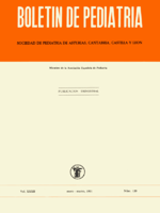Hormona del crecimiento. Otras perspectivas terapéuticas
M.F. Rivas Crespo , M. Crespo Hernández , A. Ramos Aparicio
Bol. Pediatr. 1991; 32 (139): 9 - 17
La disponibilidad actual de hormona de crecimiento recombinante (rGH), sólo condicionada por criterios financieros, permite que se piense en otras posibles utilidades terapéuticas para este nuevo medio terapéutico. Se revisan sus posibles indicaciones en la baja talla constitucional, hipocrecimiento de origen prenatal y en el fracaso renal. Las tallas bajas «variantes de la normalidad» o constitucionales, son las situaciones más frecuentes y las menos beneficiadas del recurso. Responden de forma muy escasa las variantes familiares, haciéndolo en mucho mayor grado los retrasos madurativos simples. En este último caso, el desvanecimiento de la respuesta es muy intenso y es difícil saber si, en último término, habrá diferencias significativas con otras terapéuticas más cómodas. Hay poca experiencia acerca de las formas connatales, fuera del Síndrome de Turner. Las niñas con este diagnóstico sufren un déficit somatotropo creciente, al que se suma una relativa resistencia del cartílago en su respuesta. Deben recibir rGH desde la edad escolar, junto con un esteroide, como la oxandrolona, mejorando notablemente su talla final. Tampoco es suficiente la experiencia en enfermedades crónicas orgánicas. La situación mejor estudiada es el fracaso renal. Adicionalmente al dramatismo de la situación, el crecimiento de los pacientes es catastrófico, debido a la resistencia a la GH que padecen. Precisan tratamiento con rGH, en el rango alto de la dosificación habitual. Abstract The fact that nowadays the availability of the recombinant GH (rGH) is solely conditioned by financial criteria, permits a research of her further therapeutic indications. Thus, its possible usefulness dealing with constitutional short stature, prenatal dwarfisms and chronic renal failure is being reviewed. Those cases of constitutional short stature are the most frequent cases but yet the least benefited from this recourse. Familial forms have a scanty response, whereas constitutional delays of growth and puberty have a more positive one. However, in the later, the vanning effect is very strong, so the existence in the long run of remarkable differences between this therapeutic treatment and the classic ones is difficult ro know in advance. There is not enough experience about connatal undergrowth, apart from that of the Turner syndrome. Girls in such a case suffer from a progressive GH-deficiency with a moderate metaphysal plate resistance. From their school-age, they must be treated both with rGH and with an steroid (such as oxandrolone), thus improving their final adult height. Neither is there enough knowledge of organic chronic diseases. In the terminal renal stage, the situation best studied, the plight of the patients is coupled with their catastrophic growth, due ro their proved resistance to the GH. They need rGH treatment at a higher dose than usual.
\N
\N
Artículo completo (PDF) (691 kb.)
- Endocrino-Metabolismo
